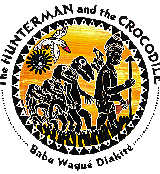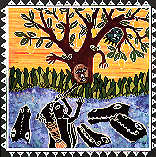


|
The Hunterman and the Crocodile; A West African Folktale.
Baba Wagué Diakité.
Subject Heading:
Preschool - grade 2 / Ages 3 - 7. *** /4
|

excerpt:
Once at the riverside, Bamba the Crocodile begged Donso to carry them deeper into the river where the current ran strong. But when the hunterman did so, Bamba took Donso's hand between his great jaws and smiled. "You know, I haven't had anything to eat in a long time," he said. "Wouldn't I be foolish to let you go?" The hunterman reminded Bamba of his promise, and they then argued at great length about right and wrong.

Right and wrong is indeed at the heart of this West African folktale retold by Baba Wagué Diakieé. Drawing on his heritage of tales told by his grandmother and others in his community from Mali, Diakiteé uses the folktale to teach about the responsibility of human beings toward nature. Donso the hunterman agrees to help a family of crocodiles exhausted by their pilgrimage to Mecca. After he has carried the four crocodiles stacked on his head back to their place in the river, Bamba the Crocodile refuses to let him go. As various animals come down to the river, Donso entreats them to help him, but they refuse, remembering all too well the exploitive nature of man who, for example, takes the hen's eggs - its children - then kills the hen at feast-time. Even the mango tree exclaims: "Mook! Let Bamba eat him!" (p17). Only the rabbit, charming in his guile, challenges them to show him how Donso could have carried all the crocodiles and so allows the hunter to take the crocodiles prisoner. But then, needing the crocodiles' tears to cure his ailing wife, Donso agrees to let them go if they will give him their tears of joy at being released. He thus breaks the cycle of taking from nature without giving in return: "Donso never forgot the lessons he learned from the cow, the horse, the chicken, the mango tree, and the rabbit. From that time forward he has reminded people of the importance of living in harmony with nature and the necessity of placing Man among - not above - all living things." (p27)
If the tale sounds familiar, this is because it has many, many versions and appears in both fables of Aesop and the Uncle Remus tales, as Diakiteé notes, even providing a short bibliography. The "Author's note" is especially engaging as it gives Diakiteé the opportunity to talk about his culture, his language and his view of storytelling. While the author explains the significance of his name in the Bambaran language and how to say hello (Awnitheé, pronounced "OW- nee-chay), he does not provide the meaning of the animals' interjection: "Mook!" The illustrations are also by the author, a noted artist, who has painted the simple but colourful pictures on ceramic tiles. The book blurb indicates that Diakiteé is a well-known as a storyteller in schools around the northwestern United States. Fortunately, with his first book, he is now reaching an even wider audience.
Highly Recommended.
Kathleen Kellett-Betsos teaches French language and Quebec/French Canadian civilisation and literature at Ryerson Polytechnic University.

To comment on this title or this review, send mail to cm@umanitoba.ca.
Copyright © 1997 the Manitoba Library Association. Reproduction for personal use is permitted only if this copyright notice is maintained. Any other reproduction is prohibited without permission.
Published by
The Manitoba Library Association
ISSN 1201-9364
TABLE OF CONTENTS FOR THIS ISSUE - JUNE 6, 1997.
AUTHORS | TITLES | MEDIA REVIEWS | BOOKSHELF | BACK ISSUES | SEARCH | HOME